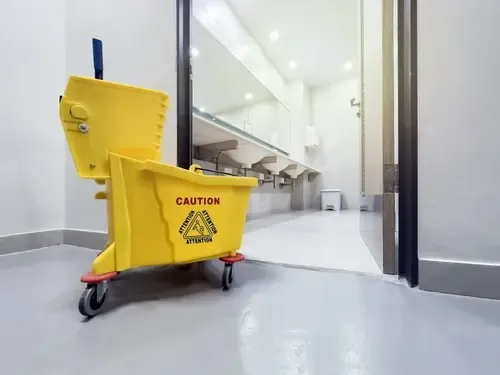How to Create a Washroom Cleaning Schedule That Works

Creating a washroom cleaning schedule might not sound glamorous, but here’s the thing—it’s one of the most important steps you can take to maintain a welcoming and functional space for employees, customers, and visitors. After all, no one wants to encounter a messy, smelly washroom.
Whether you’re a small business owner managing a shop, a facility manager overseeing multiple locations, or a janitorial staff member tasked with daily upkeep, having a smart, practical schedule for washroom cleanliness can make all the difference. This guide breaks down how you can make this task simple, efficient, and—dare we say—clean.
Why a Clean Washroom Matters
Before jumping into the how, it’s worth pausing to reflect on the why.
- Hygiene and Safety: A clean washroom reduces harmful bacteria, germs, and unpleasant odors. It’s essential for maintaining health and safety.
- Impressions Count: If you’re a customer-facing business, washroom cleanliness plays a big role in shaping how people perceive your space. A spotless washroom shows attention to detail and care.
- Employee Morale: Believe it or not, clean washrooms can help boost morale. A poorly maintained washroom screams neglect—not the kind of vibe employees appreciate in their workplace.
Now that the importance is clear, creating a practical cleaning schedule is the next step.
The Basics of a Good Washroom Cleaning Schedule
The secret to an effective cleaning schedule lies in consistency, attention to detail, and understanding your specific needs. Here’s how to make it work for your facility step by step.
1. Assess the Washroom Usage
Not all washrooms are created equal. A high-traffic cafe washroom will require more frequent cleaning than a staff-only washroom in a small office.
Ask yourself these questions:
- How many people use this washroom daily?
- Are there peak traffic times (e.g., lunch hours)?
- Is it prone to quicker wear and tear (e.g., paper towels running out, spills)?
Use these insights to determine how often the facility needs attention. Most washrooms will benefit from a cleaning frequency between two and six times a day, depending on usage.
2. Make a Checklist of Cleaning Tasks
Having a clear checklist ensures that nothing gets overlooked. Here’s an example of what a comprehensive washroom cleaning checklist might look like:
- Restock toilet paper, paper towels, and soap dispensers
- Wipe down and disinfect sinks, countertops, and handles
- Clean and sanitize toilets and urinals
- Empty trash bins and replace liners
- Sweep and mop floors
- Check for any maintenance issues (e.g., leaking taps, broken dispensers)
Post this checklist for the team to reference and tick off after every cleaning session.
3. Determine Cleaning Intervals
Your schedule should balance routine maintenance with deeper cleans.
- Daily Tasks: Basic cleaning, such as restocking and sanitizing frequently used surfaces, should be part of the daily routine. High-traffic washrooms may need morning, midday, and evening cleans.
- Weekly Tasks: Plan for more detailed tasks, like scrubbing tile grout or flushing drains, once a week.
- Monthly Tasks: Set aside time for maintenance checks (fixing broken equipment) and deep cleans (e.g., thoroughly disinfecting every corner).
4. Delegate Responsibilities Clearly
Make it easy to follow by assigning specific tasks to individuals or teams. Use a rotational plan if there are several staff members responsible for washroom cleanliness. The clearer the instructions, the more likely everyone will stick to it—no awkward guessing games or “I thought someone else was doing it.”
Consider labeling tasks by priority. Is it something urgent, like an overflowing trash can? Or something routine, like refilling soap dispensers? Give your team the tools they need to make quick decisions.
5. Track and Monitor Cleaning Efforts
Accountability is key. Logging completed tasks ensures everything gets done and can help you quickly spot any lapses in the routine.
This doesn’t have to be complicated. A simple laminated chart pinned to the back of the door works wonders:
- Include columns for the date, time, the specific tasks completed, and the initials of the staff member responsible.
- Regularly review the log to identify patterns, like rush times when cleanliness may need extra attention.
6. Review and Adjust the Schedule Regularly
No cleaning schedule is set in stone. Business growth, seasonal changes, or customer feedback can impact how well your system performs. Make a habit of reviewing the schedule at least once every quarter so you can tweak it as needed.
For example:
- Did a new product launch or promotion bring higher customer traffic? Time to ramp up those cleanings.
- Is a certain hour always leaving the washroom in shambles? Consider adding an extra revisiting touch-up during that time.
Tips for Maintaining Washroom Cleanliness
The following practical tips will keep your washroom consistently clean and easy to maintain:
- Stock Smartly: Keep a well-organized supply cabinet near the washroom with all essential items—cleaning sprays, extra paper goods, gloves, etc.
- Invest in Easy-to-Clean Fixtures: Stainless steel or touch-free dispensers and faucets reduce mess and are easier to sanitize.
- Encourage User Accountability (when appropriate): Posting friendly signs like “Please leave the washroom as clean as you found it” can subtly remind users to take care.
Create a Clean and Welcoming Space
Crafting a washroom cleaning schedule is more than a chore—it’s an investment in creating a positive, sanitary, and welcoming environment for everyone who steps inside your space. By assessing usage, planning cleaning intervals, and assigning clear responsibilities, you’re setting up for success.
Not only will this ensure cleanliness on a daily basis, but it also fosters a culture of care, providing employees and customers alike with the spaces they deserve.
Is your washroom cleanliness routine up to scratch? If not, it’s time to revamp your cleaning schedule and start reaping the rewards. A cleaner washroom means happier people—and fewer headaches for you!




